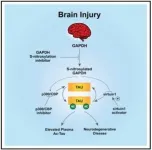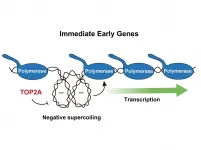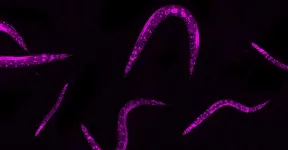Gene therapy shows promise in treating rare eye disease in mice
Findings suggest combination gene therapies that target multiple causes of eye cell death in mice could be an effective approach for treating people with retinitis pigmentosa and similar conditions
2021-04-13
(Press-News.org) A gene therapy protects eye cells in mice with a rare disorder that causes vision loss, especially when used in combination with other gene therapies, shows a study published today in eLife.
The findings suggest that this therapy, whether used alone or in combination with other gene therapies that boost eye health, may offer a new approach to preserving vision in people with retinitis pigmentosa or other conditions that cause vision loss.
Retinitis pigmentosa is a slowly progressive disease, which begins with the loss of night vision due to genetic lesions that affect rod photoreceptors - cells in the eyes that sense light when it is low. These photoreceptors die because of their intrinsic genetic defects. This then impacts cone photoreceptors, the eye cells that detect light during the day, which leads to the eventual loss of daylight vision. One theory about why cones die concerns the loss of nutrient supply, especially glucose.
Scientists have developed a few targeted gene therapies to help individuals with certain mutations that affect the photoreceptors, but no treatments are currently available that would be effective for a broad set of families with the disease. "A gene therapy that would preserve photoreceptors in people with retinitis pigmentosa regardless of their specific genetic mutation would help many more patients," says lead author Yunlu Xue, Postdoctoral Fellow at senior author Constance Cepko's lab, Harvard Medical School, Boston, US.
To find a widely effective gene therapy for the disease, Xue and colleagues screened 20 potential therapies in mouse models with the same genetic deficits as humans with retinitis pigmentosa. The team chose the therapies based on the effects they have on sugar metabolism.
Their experiments showed that using a virus carrier to deliver a gene called Txnip was the most effective approach in treating the condition across three different mouse models. A version of Txnip called C247S worked especially well, as it helped the cone photoreceptors switch to using alternative energy sources and improved mitochondria health in the cells.
The team then showed that giving the mice gene therapies that reduced oxidative stress and inflammation, along with Txnip gene therapy, provided additional protection for the cells. Further studies are now needed to confirm whether this approach would help preserve vision in people with retinitis pigmentosa.
"The immediate next step is to test Txnip for safety in animals beyond mice, before moving on to a clinical trial in humans," explains senior author and Howard Hughes Institute Investigator Constance Cepko, the Bullard Professor of Genetics and Neuroscience at Harvard Medical School. "If it ultimately proves safe in people, then we would hope to see it become an effective approach for treating those with retinitis pigmentosa and other forms of progressive vision loss, such as age-related macular degeneration."
INFORMATION:
Media contacts
Emily Packer, Media Relations Manager
eLife
e.packer@elifesciences.org
+44 (0)1223 855373
Ekaterina Pesheva, Director, Science Communications & Science Media
Harvard Medical School
Ekaterina_Pesheva@hms.harvard.edu
+1 617 432-0441
+ 1 410 926-6780
About eLife
eLife is a non-profit organisation created by funders and led by researchers. Our mission is to accelerate discovery by operating a platform for research communication that encourages and recognises the most responsible behaviours. We aim to publish work of the highest standards and importance in all areas of biology and medicine, while exploring creative new ways to improve how research is assessed and published. eLife receives financial support and strategic guidance from the Howard Hughes Medical Institute, the Knut and Alice Wallenberg Foundation, the Max Planck Society and Wellcome. Learn more at https://elifesciences.org/about.
To read the latest Medicine research published in eLife, visit https://elifesciences.org/subjects/medicine.
And for the latest in Neuroscience, see https://elifesciences.org/subjects/neuroscience.
ELSE PRESS RELEASES FROM THIS DATE:
2021-04-13
Violent blows or jolts to the head can cause traumatic brain injury (TBI), and there are currently about five million people in the U.S. living with some form of chronic impairment after suffering a TBI. Even in a mild form, TBI can lead to lifelong nerve cell deterioration associated with a wide array of neuropsychiatric conditions. Tragically, there are no medicines to protect nerve cells after injury. Behind aging and genetics, TBI is the third leading cause of Alzheimer's disease (AD), yet the link between these two conditions is not understood.
In a new study, published online today in Cell, researchers have discovered a new way to prevent brain nerve cells from deteriorating after injury, which also revealed a potential mechanistic ...
2021-04-13
AMES, Iowa - Narratives are a powerful tool that can help explain complex issues, but they can also serve as sources of misinformation, which presents a challenge as public health agencies work to educate people about COVID-19 vaccine.
In a paper published by the Proceedings of the National Academy of Sciences, author Michael Dahlstrom, a professor and director of Iowa State University's Greenlee School of Journalism and Mass Communication, examined how narratives or storytelling can help counter misinformation and provide a connection between science and the human experience. Dahlstrom says simply presenting the facts, without some connection, may not help people make ...
2021-04-13
Bottom Line: The U.S. Preventive Services Task Force (USPSTF) concludes that the current evidence is insufficient to make a recommendation about screening for vitamin D deficiency in asymptomatic adults. Vitamin D performs an important role in bone metabolism. Requirements may vary by individual and no one blood vitamin D level defines deficiency. The USPSTF routinely makes recommendations about the effectiveness of preventive care services and this recommendation updates and is consistent with its 2014 statement.
To access the embargoed study: Visit our For The Media website at this link https://media.jamanetwork.com/
(doi:10.1001/jama.2021.3069)
Editor's Note: Please see the article for additional ...
2021-04-13
New research led by the Garvan Institute of Medical Research has revealed how breast cancer cells that develop during or after pregnancy change their environment to form more aggressive tumours.
In experimental models of pregnancy-associated breast cancer, researchers found that cancer cells send signals to the connective tissue around them to trigger uncontrolled inflammation and remodel the tissue, which in turn helps the cancer to spread.
"Breast cancers that arise during or shortly after pregnancy are highly aggressive as they often become resistant to standard therapies. With 50% of cases ...
2021-04-13
Huntington's disease is a genetic neurodegenerative disorder caused by mutations in the protein huntingtin and characterized by involuntary dance-like movements, severe behavioural changes and cognitive impairment. That neuronal traffic is impaired in this disease has been very well known for several years. But that this deranged trafficking could be ameliorated by increasing huntingtin methylation was not yet known. The findings emerged from an international research work coordinated by the University of Trento and published in Cell Reports.
The research teams identified the fundamental role of the protein arginine methyltransferase PRMT6 in ensuring transport along axons, the routes that connect nerve cells to each other, and hence the health of neurons. ...
2021-04-13
Researchers from the group of Hans Clevers (Hubrecht Institute) developed the first patient-derived organoid model for cervical cancer. They also modelled the healthy human cervix using organoids. In close collaboration with the UMC Utrecht, Princess Máxima Center for pediatric oncology and the Netherlands Cancer Institute, the researchers used the organoid-based platform to study sexually transmitted infections for a herpes virus. The model can potentially also be used to study the human papillomavirus (HPV), which is one of the main causes of cervical cancer. The results were published in Cell Stem Cell on the 13th of April.
Cervical cancer is a common gynecological malignancy, often caused by the human papillomavirus (HPV). However, good models to study human ...
2021-04-13
(Boston)--How could studying gastrointestinal cells help the fight against COVD-19, which is a respiratory disease? According to a team led by Gustavo Mostoslavsky, MD, PhD, at the BU/BMC Center for Regenerative Medicine (CReM) and Elke Mühlberger, PhD, from the National Emerging Infectious Diseases Laboratories (NEIDL) at Boston University, testing how SARS-CoV-2 affects the gut can potentially serve to test novel therapeutics for COVID-19.
In order to study SARS-CoV-2, models are needed that can duplicate disease development in humans, identify potential targets and enable drug testing. BU researchers have created human induced pluripotent stem cells (iPSC)-derived intestinal organoids or 3-D models that can be infected and replicated ...
2021-04-13
The (when stretched) two-metre-long DNA molecule in each human cell is continuously being unpacked and packed again to enable the expression of genetic information. When genes must be accessed for transcription, the DNA double helix unwinds and the strands separate from each other so that all the elements needed for gene expression can access the relevant DNA region. This process results in the accumulation of DNA supercoiling that needs to be resolved. A study recently published by Felipe Cortés, Head of the Topology and DNA Breaks Group at the Spanish National Cancer Research Centre (CNIO), and the members of his team, in cooperation with Silvia Jimeno González, Professor ...
2021-04-13
Understanding the effects of specific mutations in gene regulatory regions - the sections of DNA and RNA that turn genes on and off - is important to unraveling how the genome works, as well as normal development and disease. But studying a large variety of mutations in these regulatory regions in a systematic way is a monumental task. While progress has been made in cell lines and yeast, few studies in live animals have been done, especially in large populations.
Experimental and computational biologists at the Max Delbrück Center for Molecular Medicine in the Helmholtz Association (MDC) have teamed up to establish an approach to induce thousands of different mutations in up to 1 million ...
2021-04-13
Electrochemical processes could be used to convert CO2 into useful starting materials for industry. To optimise the processes, chemists are attempting to calculate in detail the energy costs caused by the various reaction partners and steps. Researchers from Ruhr-Universität Bochum (RUB) and Sorbonne Université in Paris have discovered how small hydrophobic molecules, such as CO2, contribute to the energy costs of such reactions by analysing how the molecules interact in water at the interface. The team describes the results in the journal Proceedings of the National Academy of Sciences, PNAS for short, published online on 13 April 2021.
To conduct the ...
LAST 30 PRESS RELEASES:
[Press-News.org] Gene therapy shows promise in treating rare eye disease in mice
Findings suggest combination gene therapies that target multiple causes of eye cell death in mice could be an effective approach for treating people with retinitis pigmentosa and similar conditions




